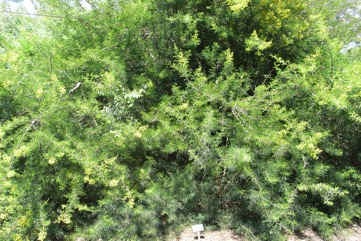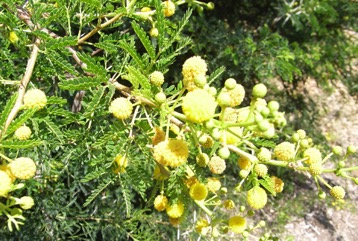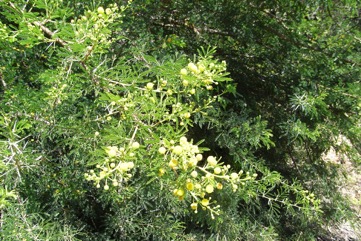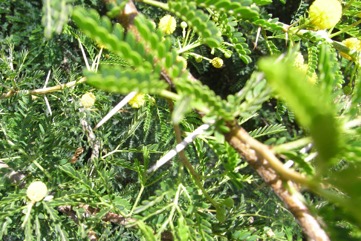Karroo Thorn, Cape gum

This is a native of Southern Africa. It prefers light to medium soils They need to be well drained. It requires a sunny protected position. It can resist drought and frost. It grows in areas with an annual rainfall between 50-1,500 mm. It grows between 3-2,400 m above sea level. It grows in coastal scrub and woodland and along streams. It can grow in arid places. It suits hardiness zones 9-11.
Also known as:
Cape gum, Doorn Boom, Isinga, Mfungu, Mimosa, Mkwangwa, Moangala, Mooka, Mpampa, Mubayamhondoro, Muhunga, Munenje, Muye-nyewe, Muzunga, Soetdoring, Sweet thorn, Umnga, Umunga
Synonyms
- Acacia dekindtiana A. Chev.
- Acacia eburnea sensu auct.
- Acacia inconflagrabilis Gerstner
- Acacia horrida sensu auct. mult. non (L.) Willd.
- Acacia karroo Hayne
- Acacia natalitia E. Meyer
- Confusion about these: Acacia pseudowightii Thoth.
- Acacia roxburghii Wight & Arn.
- Acacia campbellii Arn.
- Mimosa eburnea L. f.
- Acacia minutifolia Ragnup.
- Acacia hirtella E. Mey.
Edible Portion
- Seeds - coffee, Gum, Bark, Roots, Seeds, Leaves - coffee
Where does Karroo Thorn grow?
Found in: Africa, Angola, Australia, Botswana, Central Africa, Cyprus, East Africa, Egypt, Eswatini, Europe, Lesotho, India, Iraq, Libya, Malawi, Mauritius, Mediterranean, Morocco, Mozambique, Namibia, North Africa, Portugal, South Africa, Southern Africa, Spain, St Helena, Swaziland, West Africa, Zambia, Zimbabwe
Notes: There are about 1,350 Acacia species. Over 1,000 occur in Australia. It can become a weed. Also as Mimosaceae.
Status: The gum is chewed especially by children.
Growing Karroo Thorn, Cape gum
Cultivation: It is grown from seed. The seed needs to be treated to break the hard seed coat. Normally this is by putting the seeds in very hot water and letting the water cool down overnight then planting the seeds immediately. Seeds grow quickly. Seeds germinate in 3-12 days and can be transplanted when young.
Edible Uses: The tree oozes a clear red-gold gum which is chewed. It is sweet and eaten by children. The seeds are roasted and ground then used as a substitute for coffee. The inner bark is chewed.
Production: Plants are fast growing.
Nutrition Info
per 100g edible portion| Edible Part | Energy (kcal) | Protein (g) | Iron (mg) | Vitamin A (ug) | Vitamin c (mg) | Zinc (mg) | % Water |
|---|---|---|---|---|---|---|---|
| Gum | 313 | 6.8 | 16.6 | - | - | 0.3 | 13.9 |
| Seeds - coffee | - | - | - | - | - | - |
Karroo Thorn, Cape gum Photos




References
Barwick, M., 2004, Tropical and Subtropical Trees. A Worldwide Encyclopedic Guide. Thames and Hudson p 3 (As Acacia karroo)
Blamey, M and Grey-Wilson, C., 2005, Wild flowers of the Mediterranean. A & C Black London. p 79 (As Acacia karroo)
Bodkin, F., 1991, Encyclopedia Botanica. Cornstalk publishing, p 22 (As Acacia karroo)
Burkill, H. M., 1985, The useful plants of west tropical Africa, Vol. 3. Kew. (As Acacia karroo)
Cundall, P., (ed.), 2004, Gardening Australia: flora: the gardener's bible. ABC Books. p 76 (As Acacia karroo)
De Vynk, J. C., et al, 2016, Indigenous edible plant use by contemporary Khoe-San descendants of South Africa's Cape South Coast. South African Journal of Botany. 102 (2016) 60-69 (As Acacia karroo)
Drummond, R. B., 1981, Common Trees of the Central Watershed Woodlands of Zimbabwe, National Herbarium Salisbury. p 46 (As Acacia karroo)
Etherington, K., & Imwold, D., (Eds), 2001, Botanica's Trees & Shrubs. The illustrated A-Z of over 8500 trees and shrubs. Random House, Australia. p 53 (As Acacia karroo)
Fowler, D. G., 2007, Zambian Plants: Their Vernacular Names and Uses. Kew. p 32 (As Acacia karroo)
Fox, F. W. & Young, M. E. N., 1982, Food from the Veld. Delta Books. p 198 (As Acacia karroo)
Getreue Darstell. Gew. 10: t. 33. 1827 (As Acacia karroo)
Grivetti, J., 1976, (As Acacia karroo)
Grivetti, L. E., 1980, Agricultural development: present and potential role of edible wild plants. Part 2: Sub-Saharan Africa, Report to the Department of State Agency for International Development. p 79 (As Acacia karroo)
Joffe, P., 2007, Creative Gardening with Indigenous Plants. A South African Guide. Briza. p 87 (As Acacia karroo)
Le Houerou, H. N., (Ed.), 1980, Browse in Africa. The current state of knowledge. International Livestock Centre for Africa, Ethiopia. p 162 (As Acacia karroo)
Long, C., 2005, Swaziland's Flora - siSwati names and Uses http://www.sntc.org.sz/flora/ (As Acacia karroo)
Mannheimer, C. A. & Curtis. B.A. (eds), 2009, Le Roux and Muller's Field Guide to the Trees and Shrubs of Namibia. Windhoek: Macmillan Education Namibia. p 102 (As Acacia karroo)
Maroyi, A., 2011, The Gathering and Consumption of Wild Edible Plants in Nhema Communal Area, Midlands Province, Zimbabwe. Ecology of Food and Nutrition 50:6, 506-525 (As Acacia karroo)
Paczkowska, G . & Chapman, A.R., 2000, The Western Australian Flora. A Descriptive Catalogue. Western Australian Herbarium. p 312 (As Acacia karroo)
Palgrave, K.C., 1996, Trees of Southern Africa. Struik Publishers. p 241 (As Acacia karroo)
Palmer, E and Pitman, N., 1972, Trees of Southern Africa. Vol. 2. A.A. Balkema, Cape Town p 700 (As Acacia karroo)
Peters, C. R., O'Brien, E. M., and Drummond, R.B., 1992, Edible Wild plants of Sub-saharan Africa. Kew. p 126 (As Acacia karroo)
Plowes, N. J. & Taylor, F. W., 1997, The Processing of Indigenous Fruits and other Wildfoods of Southern Africa. in Smartt, L. & Haq. (Eds) Domestication, Production and Utilization of New Crops. ICUC p 184 (As Acacia karroo)
Roodt, V., 1998, Trees & Shrubs of the Okavango Delta. Medicinal Uses and Nutritional value. The Shell Field Guide Series: Part 1. Shell Botswana. p 193 (As Acacia karroo)
Royal Botanic Gardens, Kew (1999). Survey of Economic Plants for Arid and Semi-Arid Lands (SEPASAL) database. Published on the Internet; http://www.rbgkew.org.uk/ceb/sepasal/internet [Accessed 26th April 2011] (As Acacia karroo)
Ruiters-Welcome, A. K., 2019, Food plants of southern Africa. Ph.D. thesis. Univ. of Johannesburg p 62
Schmidt, E., Lotter, M., & McCleland, W., 2007, Trees and shrubs of Mpumalanga and Kruger National Park. Jacana Media p 154 (As Acacia karroo)
Shava, S., 2000, The Use of Indigenous Plants as Food by a Rural Community in the Eastern Cape: an Educational Exploration. Masters Thesis Rhodes University. p 63 (As Acacia karroo)
Tredgold, M.H., 1986, Food Plants of Zimbabwe. Mambo Press. p 81 (As Acacia karroo)
Uphof, (As Acacia karroo)
van Wyk, B, van Wyk, P, and van Wyk B., 2000, Photographic guide to Trees of Southern Africa. Briza. p 33 (As Acacia karroo)
Van Wyk, Br. and van Wyk P., 2009, Field Guide to Trees of Southern Africa. Struik Nature. p 494 (As Acacia karroo)
van Wyk, Be., & Gericke, N., 2007, People's plants. A Guide to Useful Plants of Southern Africa. Briza. p 100 (As Acacia karroo)
van Wyk, B-E., 2011, The potential of South African plants in the development of new food and beverage products. South African Journal of Botany 77 (2011) 857–868 (As Acacia karroo)
van Wyk, Ben-Erik, 2019, The diversity and multiple uses of southern African legumes. Australian Systematic Botany, 2019, 32, 519–546
Venter, F & J., 2009, Making the most of Indigenous Trees. Briza. p 22 (As Acacia karroo)
Williamson, J., 2005, Useful Plants of Malawi. 3rd. Edition. Mdadzi Book Trust. p 10 (As Acacia karroo)
World Checklist of Useful Plant Species 2020. Royal Botanic Gardens, Kew
www.zimbabweflora.co.zw 2011 (As Acacia karroo)
Young, J., (Ed.), 2001, Botanica's Pocket Trees and Shrubs. Random House. p 48 (As Acacia karroo)